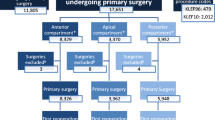Abstract
Objective:To compare the pre- and intraoperative situation using the POP-Q system during optimally standardized conditions of both examinations. Study design: In a prospective observational study, 108 women were compared. The POP-Q in the outpatient department (preoperative) was compared with the situation just prior to surgery after full anesthesia was reached (intraoperative). During the intraoperative measurement, traction with 0.5 kg force was applied on all relevant places. Results: The pre- and intraoperative measurements were all significant correlated with the R-values between 0.43 and 0.85. All six points, which are measured during the POP-Q, were more prolapsed in the intra- as compared with the preoperative situation. The points Bp, C, and D were significantly more prolapsed, but for the points Aa, Ba, and Ap this was not significant. Fifteen patients were upstaged by the intraoperative measurements and five patients were downstaged in the overall POP-Q grading system. Conclusions: Intraoperative evaluation of the prolapse can reveal significant changes as compared with the preoperative situation. In general, the prolapse is more pronounced especially in the middle and posterior compartment.


Similar content being viewed by others
References
Olsen AL, Smith V, Bergstrom JO, Colling JC, Clark AL (1997) Epidemiology of surgically managed pelvic organ prolapse and urinary incontinence. Obstet Gynecol 89:501–506
Friedman EA, Little WA (1961) The conflict of nomenclature for descensus uteri. Am J Obstet Gynecol 81:817–820
Porges RF (1963) A practical system of diagnosis and classification of pelvic relaxations. Surg Gynecol Obstet 117:761–773
Baden WF, Walker TA (1972) Genesis of the vaginal profile: a correlated classification of pelvic relaxation. Clin Obstet Gynecol 15:1048–1054
Brubaker L, Norton P (1996) Current clinical nomenclature for description of pelvic organ prolapse. J Pelvic Surg 2:257–259
Bump RC, Matiason A, Bo K, Brubaker LP, DeLancey JOL, Klarskov P, Shull BL, Smith ARB (1996) The standardisation of terminology of female pelvic floor dysfunction. Am J Obstet Gynecol 175:10–17
Hall AF, Theofrastous JP, Cundiff GW, Harris RL, Hamilton LF, Swift SE, Bump RC (1996) Interobserver and intraobserver reliability of the proposed International Continence Society, Society of Gynecologic Surgeons and American Urogynecologic Society pelvic organ prolapse classification system. Am J Obstet Gynecol 175:1467–1471
Steele A, Malipeddi P, Welgoss J, Soled S, Kohli N, Karram M (1998) Teaching the pelvic organ prolapse quantitation system. Am J Obstet Gynecol 179:1458–1464
Bland DR, Earle BB, Vitolins MZ, Burke G (1999) Use of the pelvic organ prolapse staging system of the International Continence Society in perimenopausal women. Am J Obstet Gynecol 181:1324–1328
Nichols DH, Randall CL (1996) Vaginal surgery. 4th edn. Williams& Wilkins, Baltimore
Vineyard DD, Kuehl TJ, Coates KW, Shull BL (2002) A comparison of preoperative and intraoperative evaluations for patients who undergo site-specific operation for the correction of pelvic organ prolapse. Am J Obstet Gynecol 186:1155–1159
Haeusler G, Sam G, Chiari A, Tempfer C, Hanzal E, Koelbl H (1998) Effect of spinal anesthesia on the lower urinary tract in continent women. Br J Obstet Gynecol 105:103–106
Bartsscht KD, DeLancey JOL (1988) A technique to study the passive supports of the uterus. Obstet Gynecol 72:940–943
Handa VL, Garett E, Hendrix S, Gold E, Robbins J (2004) Progression and remission of pelvic organ prolapse: a longitudinal study of menopausal women. Am J Obstet Gynecol 190:27–32
Author information
Authors and Affiliations
Corresponding author
Rights and permissions
About this article
Cite this article
Vierhout, M.E., Stoutjesdijk, J. & Spruijt, J. A comparison of preoperative and intraoperative evaluation of patients undergoing pelvic reconstructive surgery for pelvic organ prolapse using the pelvic organ prolapse quantification system. Int Urogynecol J 17, 46–49 (2006). https://doi.org/10.1007/s00192-005-1347-9
Received:
Accepted:
Published:
Issue Date:
DOI: https://doi.org/10.1007/s00192-005-1347-9




